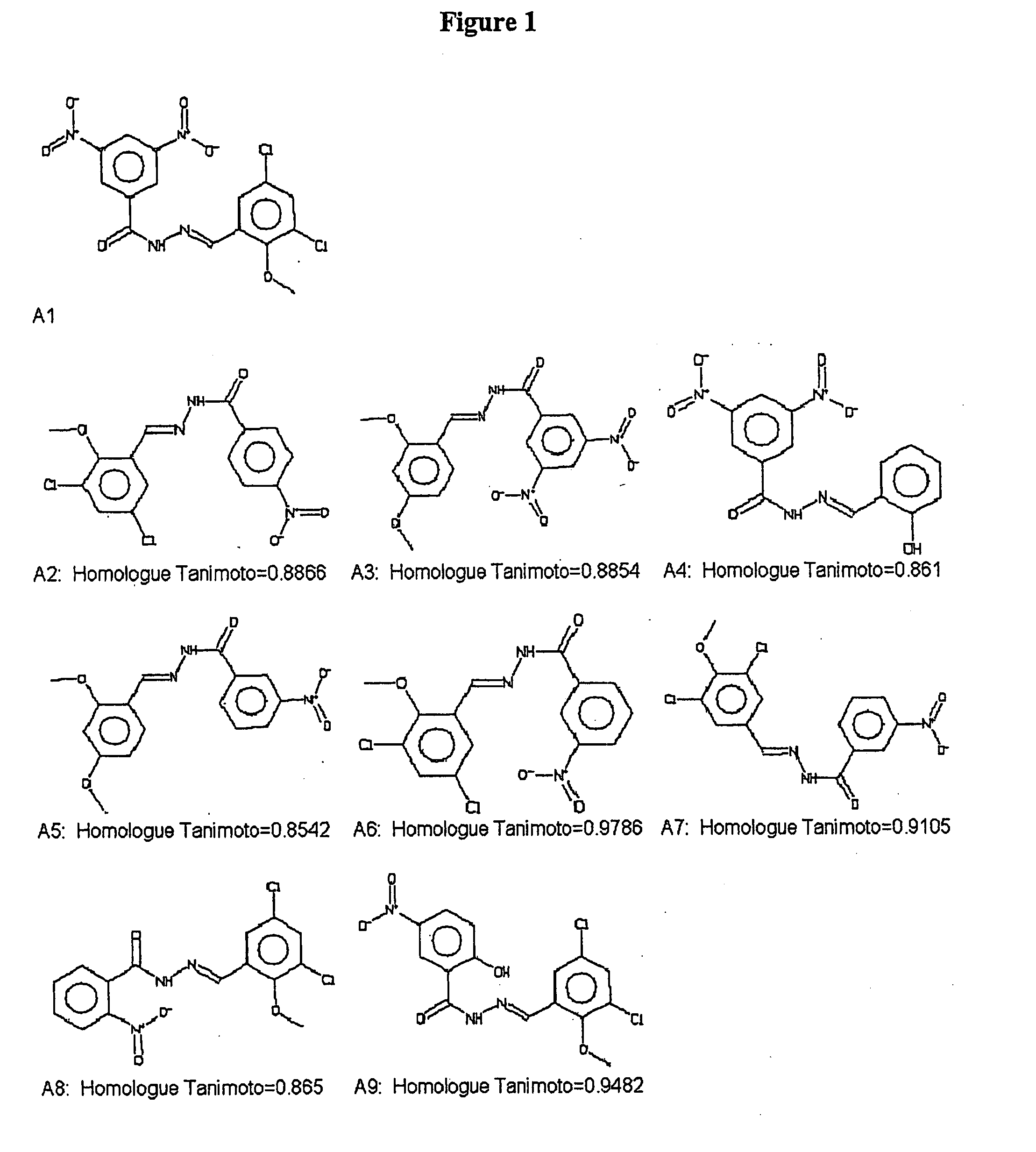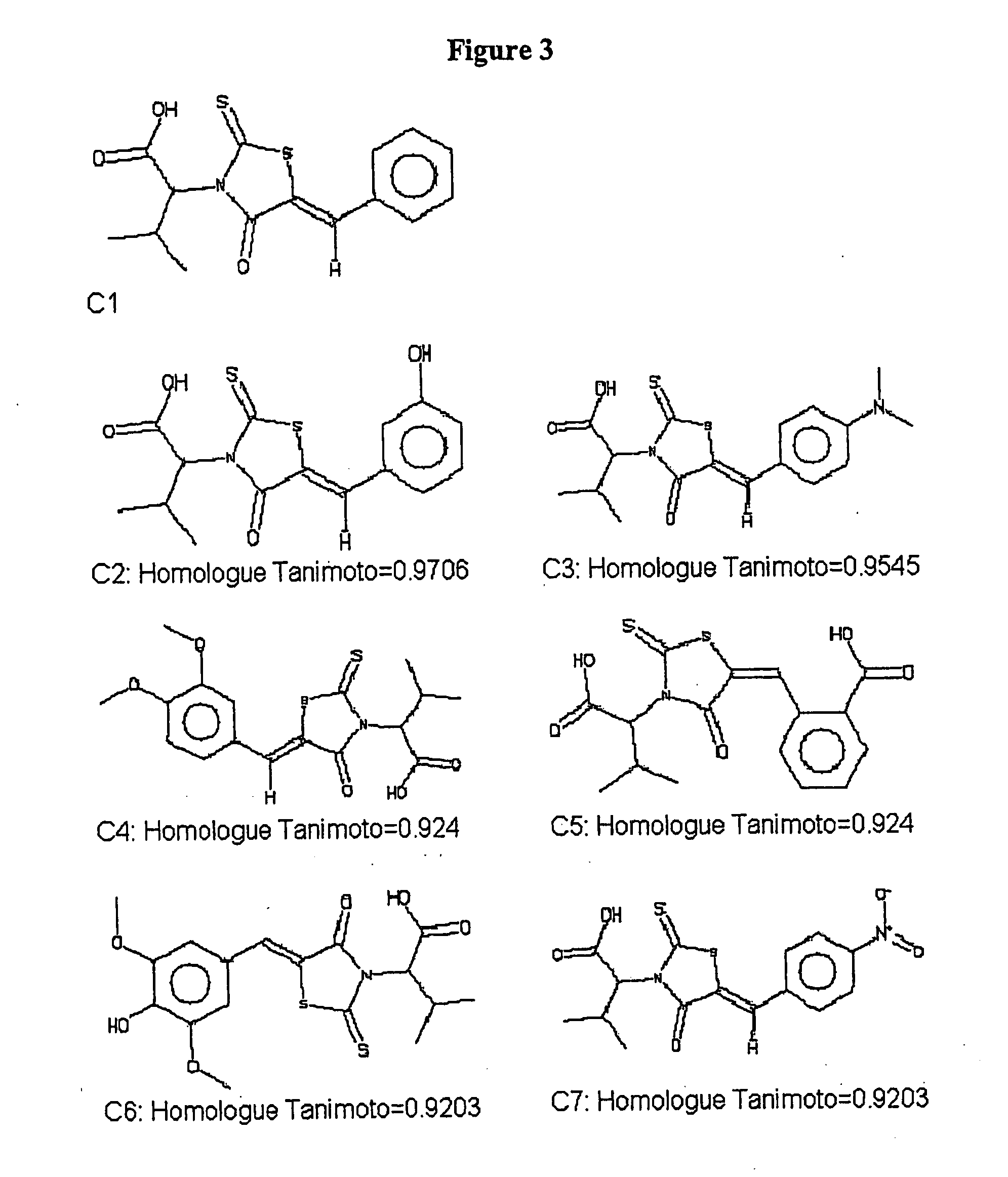Methods for screening antimicrobial and antiviral compounds and uses thereof
a technology of antiviral compounds and screening methods, applied in the field of antimicrobials and antivirals, can solve the problems of high background of toxic compounds or compounds with poor pharmacokinetic properties in synthetic compound libraries, the inability of most synthetic leads to penetrate across the multi-drug spectrum, and the inability to meet the expected need for the foreseeable future. to achieve the effect of increasing the longevity of an organism
- Summary
- Abstract
- Description
- Claims
- Application Information
AI Technical Summary
Benefits of technology
Problems solved by technology
Method used
Image
Examples
example 1
High-Throughput C. elegans Chemical Screens
[0192]We developed protocols to perform automated, high-throughput (HT) whole-animal chemical screens. The described methods enable quantitative analyses of a wide range of biological processes such as the response to different types of biotic (pathogens) or abiotic (heavy metals, ultraviolet radiation, heat) stresses that affect viability, as well as traditional longevity studies. We optimized methods to perform screens in liquid media. In particular, for 96- and 384-well format, small perturbations such as salt concentration, amount of food, and the number of animals has a greater effect than in an assay using a larger format.
[0193]Exemplary assays described herein were designed to screen for compounds (e.g., low molecular weight compounds) that prevent the lethal effect of the infection of C. elegans by a pathogen such as the bacterial pathogen Enterococcus faecalis. C. elegans were first grown to the young adult stage and then infected ...
example 2
High-Throughput C. elegans Screen for Identifying Chemical Compounds with Antimicrobial Activity
Materials and Methods
[0221]Bacterial and Nematode Strains.
[0222]Wild-type Bristol N2 (Brenner S., Genetics 77: 71-94 (1974)) and glp-4(bn2ts);sek-1 (km4) (Beanan et al., Development 116:755-766 (1992); and Tanaka-Hino et al., EMBO Rep 3:56-62 (2002)) C. elegans strains were maintained using standard practices (see Lewis et al., Basic Culture Methods. In: Epstein H F, Shakes D C, editors. Caenorhabditis elegans Modern Biological Analysis of an Organism. San Diego, Calif.: Academic Press. pp. 3-29 (1995)). E. faecalis strains MMH594 (Huycke et al., Antimicrob. Agents Chemother. 35:1626-1634 (1991)), OG1RF (Murray et al., J. Bacteriol. 175:5216-5223 (1993)), OG1RF ΔfsrB (Qin et al., Infect. Immun. 68:2579-2586 (2000)), V583 (Sahm et al., Antimicrob. Agents Chemother. 33:1588-1591 (1989)), VS583 (Moy et al., Infect. Immun. 72:4512-4520 (1989)) and E. faecium strains DO (Arduino et al., Infect...
example 3
High-Throughput C. elegans Screen for Identifying Chemical Compounds with Antifungal Activity
[0234]Our objective was to develop a semi-automated, high throughput, whole animal C. elegans assay useful for identifying chemical compounds with antifungal activity. Key features of the C. elegans assay are that it allows concurrent evaluation of toxicity and antifungal activity and that it identifies compounds that target important pathways associated with human Candida infection, including filament formation. Moreover, the assay allows the study of Candida cells that are in non-planktonic form and identification of antifungal compounds in a system where both the pathogen and the host can be genetically manipulated.
[0235]Materials and Methods.
[0236]Strains and Media.
[0237]The Candida strains used in these experiments are summarized in Table 3 or described in the text. Yeast cultures were maintained on Yeast Peptone Dextrose (YPD, Difco) agar or as frozen stocks. The C. elegans strains wer...
PUM
| Property | Measurement | Unit |
|---|---|---|
| Volume | aaaaa | aaaaa |
| Volume | aaaaa | aaaaa |
| Mass | aaaaa | aaaaa |
Abstract
Description
Claims
Application Information
 Login to View More
Login to View More - R&D
- Intellectual Property
- Life Sciences
- Materials
- Tech Scout
- Unparalleled Data Quality
- Higher Quality Content
- 60% Fewer Hallucinations
Browse by: Latest US Patents, China's latest patents, Technical Efficacy Thesaurus, Application Domain, Technology Topic, Popular Technical Reports.
© 2025 PatSnap. All rights reserved.Legal|Privacy policy|Modern Slavery Act Transparency Statement|Sitemap|About US| Contact US: help@patsnap.com



